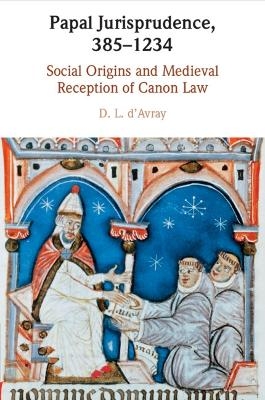
Papal Jurisprudence, 385–1234
Cambridge University Press (Verlag)
978-1-108-46086-6 (ISBN)
Why did bishops turn to the papacy for advice in late Antiquity? And what does the reception of these decretals reveal about the legal and religious culture of the mid-thirteenth century? This interpretative volume seeks to explain the first decretal age of late antiquity, placing the increased demand for papal jurisprudence – long before it exerted its influence through religious fear – within its social broad context. D. L. d'Avray then traces the reception of this jurisprudence through to the mid-thirteenth century, and the post-Gratian decretal age. Along the way he explores the role of Charlemagne and 'Pseudo-Isidore', which included many genuine early decretals alongside forged ones. Similarities between the Latin world c. 400 and c. 1200 thus help explain parallels between the two decretal ages. This book also analyses decretals from both ages in chapters on pagan marriages, clerics in minor orders, and episcopal elections. For both ages the relation between canon law and other religious genres is elucidated, demonstrating many fascinating parallels and connections.
D. L. d'Avray is Professor Emeritus of History at University College London. He has published widely on medieval preaching, death and kingship, marriage, rationalities, and the papacy. His previous publications include the companion volume of texts, Papal Jurisprudence c. 400: Sources of the Canon Law Tradition (Cambridge, 2019); Papacy, Monarchy and Marriage, 860–1600 (Cambridge, 2015); and Dissolving Royal Marriages: A Documentary History, 860–1600 (Cambridge, 2014). He has been Fellow of the British Academy since 2005 and Corresponding Fellow of the Medieval Academy of America since 2016.
Introduction; 1. Transformations and long-term explanations; 2. The Christian Roman empire, c. 400; 3. c. 400: practical complexities and uncertainties; 4. c. 400: uncertainty about grace; 5. Papal rulings and ritual; 6. Hierarchies; 7. Clerical status and monks; 8. Returning heretics; 9. Pelagianism and the papacy; 10. Leo I; 11. Post-imperial syntheses; 12. Early papal laws in the barbarian west; 13. Carolingian culture and its legacy; 14. 1050–1150; 15. Theology and law; 16. c. 400 and c. 1200: complexity, conversion and bigamia; 17. Clerics in minor orders; 18. Choosing bishops; 19. Overall conclusions; Appendix A. Leo I; Appendix B. Gelasius; Appendix C. Gloss II (Johannes Teutonicus and Bartholomaeus Brixiensis) on Gratian and the liber extra; Appendix D. Conceptual sources.
| Erscheinungsdatum | 14.05.2024 |
|---|---|
| Zusatzinfo | Worked examples or Exercises |
| Verlagsort | Cambridge |
| Sprache | englisch |
| Themenwelt | Geschichte ► Allgemeine Geschichte ► Vor- und Frühgeschichte |
| Geschichte ► Allgemeine Geschichte ► Mittelalter | |
| Geisteswissenschaften ► Geschichte ► Regional- / Ländergeschichte | |
| ISBN-10 | 1-108-46086-0 / 1108460860 |
| ISBN-13 | 978-1-108-46086-6 / 9781108460866 |
| Zustand | Neuware |
| Informationen gemäß Produktsicherheitsverordnung (GPSR) | |
| Haben Sie eine Frage zum Produkt? |
aus dem Bereich


